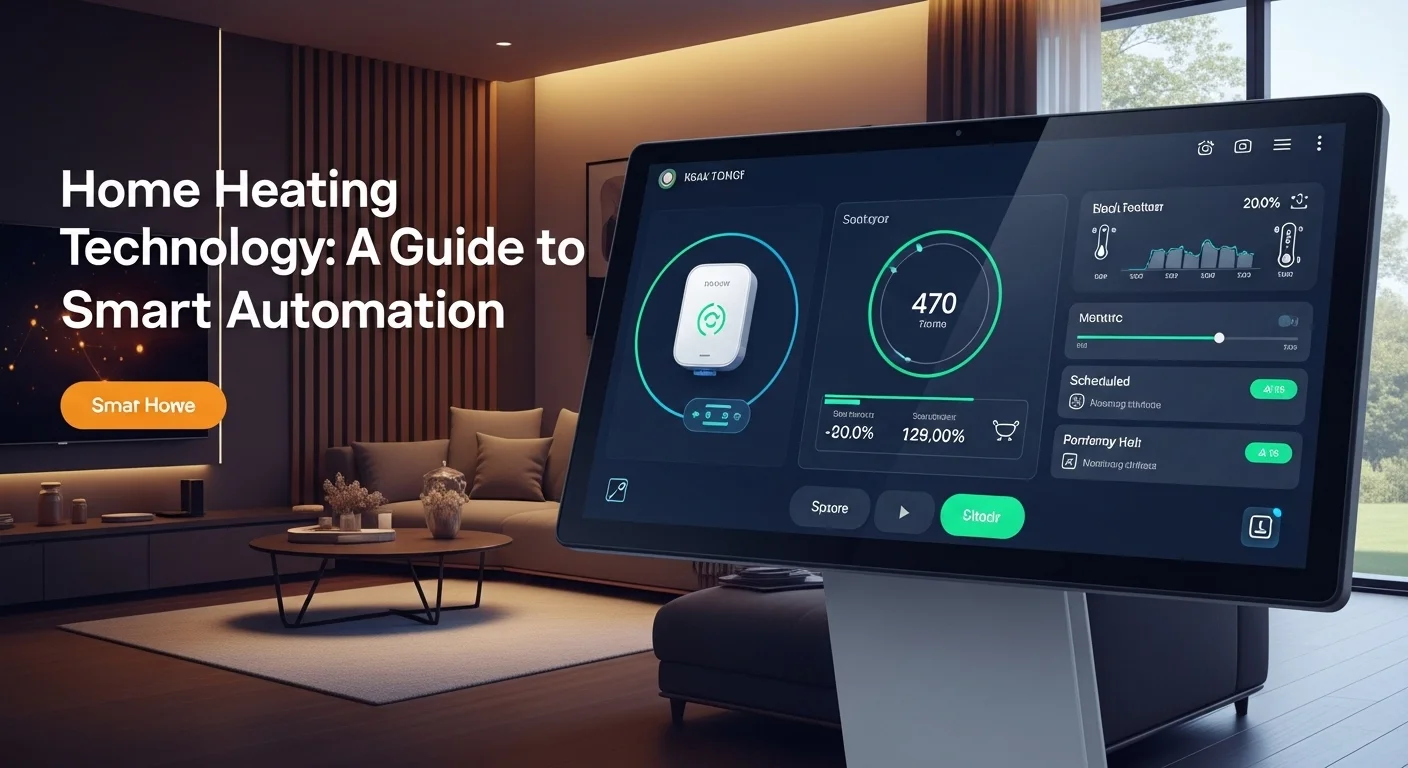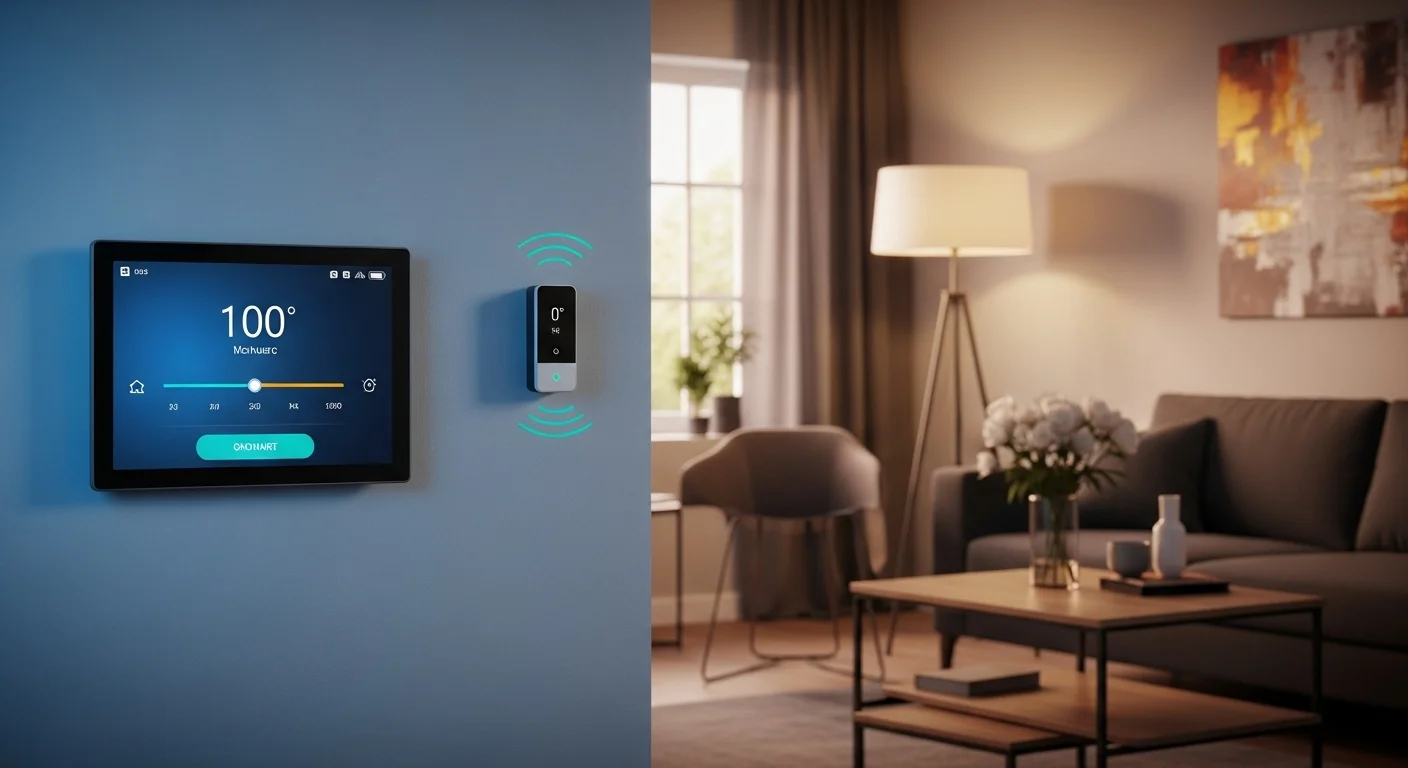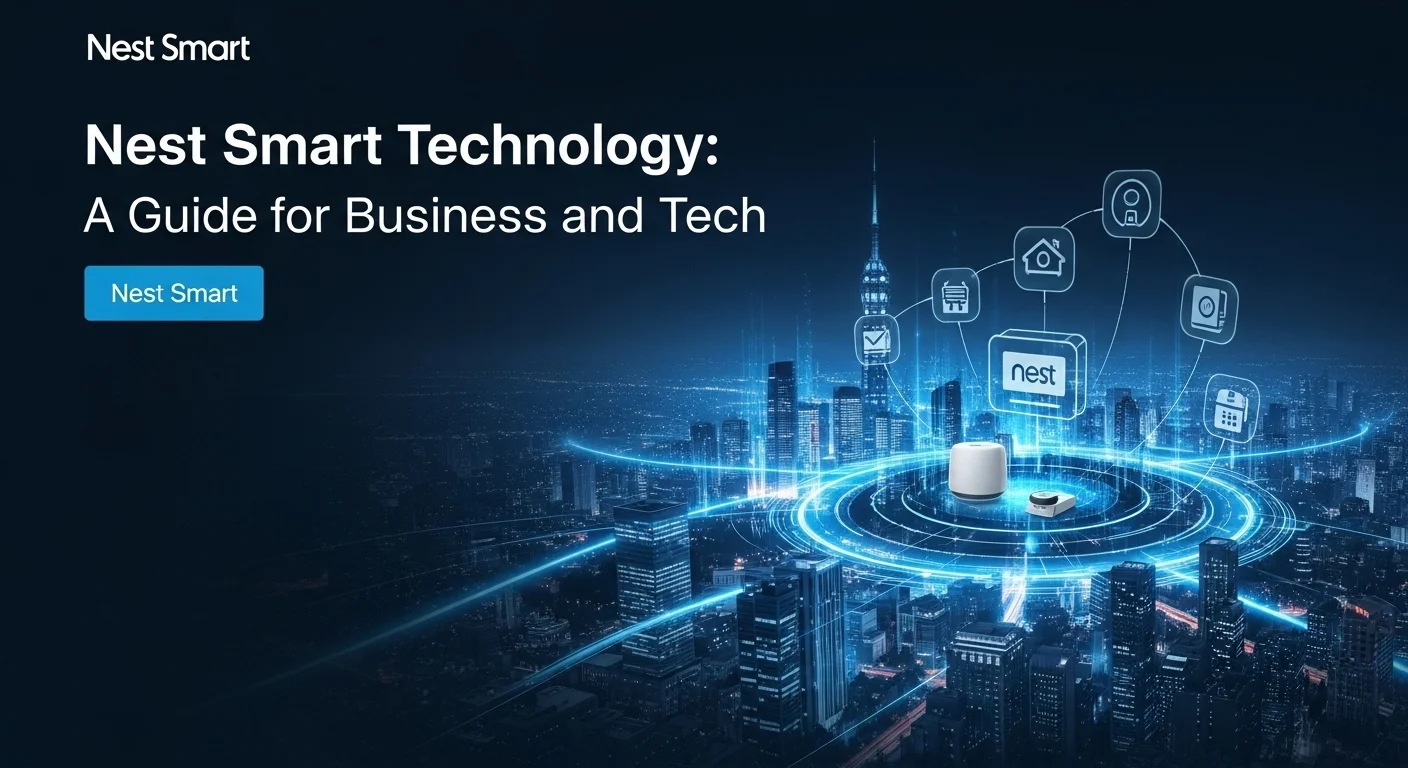Smarter Heating: My Guide to Automated Comfort and Lower Bills

Executive Summary
I still remember the first time I set up a truly smart heating system. It wasn't just about controlling the thermostat from my phone; it was watching the house automatically lower the temperature when the last person left and then gently warm up just before I got home. That's when it clicked: this isn't a gimmick. This is a real leap forward in how we live, combining comfort, efficiency, and a bit of tech magic. We've moved far beyond old manual dials into an age of intelligent systems that learn our routines. In this article, I’ll walk you through what's at the heart of modern heating tech. For my fellow tech enthusiasts, we'll dive deep into DIY automation with my favorite platform, Home Assistant, which gives you ultimate control. For business owners, I’ll highlight the massive opportunities this growing market offers. We'll cover everything from the basic gear you need to the crucial importance of keeping it all secure. My goal is to give you the practical knowledge to understand, build, and innovate with smart heating.
Table of Contents
- What is Smart Heating and Why Does It Matter?
- The Complete Guide: Commercial Off-the-Shelf Systems
- The Complete Guide: The DIY Revolution with Home Assistant
- The Complete Guide: Business Solutions and Opportunities
- Pro Tips & Strategies: Best Practices for Everyone
- Pro Tips & Strategies: Advanced Home Assistant Automations
- Pro Tips & Strategies: The Non-Negotiable Step of Cybersecurity
What is Smart Heating and Why Does It Matter?
For decades, heating our homes was a pretty dumb process. You set a temperature, and the system blasted away until it hit that number, whether you were home, asleep, or on vacation. That's all changed. Today, smart heating technology is about creating an intelligent ecosystem that automates and optimizes your home's HVAC system. Think of it as moving from a simple light switch to a fully automated lighting system that knows which rooms you're in. It's not just remote control; it's about building a heating system that responds to your life and the world around it.
So why is this such a big deal? The number one reason is energy efficiency. Let's be honest, traditional heating systems are wasteful. They run on rigid schedules and have no idea if a window is open or if everyone has left for the day. A smart system, on the other hand, is a data sponge. It uses motion sensors, weather forecasts, and the location of your phone to heat your home only when and where it's needed. I've seen clients cut their energy bills significantly just by letting the system make smarter choices. This not only saves you money but also reduces your carbon footprint, which is a huge win for everyone.
Beyond the savings, it's the integration that truly excites me as a tech professional. A smart heating system becomes the environmental nerve center of your home, and that data can be used for so much more. For example, your thermostat's humidity reading can automatically trigger a smart dehumidifier. This is where the real magic of home automation begins. For us tinkerers, the holy grail isn't just buying one brand's solution; it's about building a system that perfectly fits our needs. This is why open-source platforms like Home Assistant have become so popular. Setting up heating automation in Home Assistant lets you escape the walled gardens of big brands. You can write a custom script that, for instance, checks if a window is open before turning on the heat in that room, or gradually warms the house based on your commute home. This level of granular control is something you just can't get out of a box, and it's what pushes the whole industry forward.
From a business perspective, this field is exploding. For HVAC installers, offering smart upgrades is now essential. I've seen companies shift their entire business model from just fixing broken furnaces to providing proactive, data-driven service contracts. Imagine getting an alert that a client's system is showing signs of failure *before* it breaks down in the middle of winter. That’s a powerful service. Property managers can control heating across dozens of apartments remotely, saving a fortune in energy costs between tenants. But with all this connectivity comes a serious responsibility: cybersecurity. Every connected thermostat is a potential door into a home network. A hacked HVAC system isn't just an inconvenience; it can be a real security threat. That's why solid security—encrypted signals, regular software updates, and secure passwords—is an absolute must for any smart heating product or setup.
To really get it, let's break down what a system is made of. First, you have the hardware—the 'senses' and 'muscles.' The senses are your sensors: temperature, humidity, motion, and even door/window contacts. The muscles are the actuators, like smart radiator valves (TRVs) that control hot water flow to individual radiators, or a simple relay switch that tells your main boiler to turn on or off. The quality of these parts is crucial. In my own Home Assistant setup, I learned early on that relying on a single, poorly placed temperature sensor can throw the whole system off. It’s often better to use a dedicated sensor placed in the middle of the room.
Next is connectivity. These devices need to talk to each other. Wi-Fi is common, but it can drain batteries quickly. That's why protocols like Zigbee and Z-Wave are so popular for home automation; they're low-power and create a reliable 'mesh' network where devices can relay signals for each other. The new 'Matter' standard is trying to get all these different devices to speak the same language, which will be a huge help for consumers.
Finally, there's the 'brain' of the operation—the control hub. For commercial products from brands like Nest or Hive, this brain is usually in the cloud. It's convenient but means you're dependent on their servers and an internet connection. The alternative, and my personal preference, is a local hub like Home Assistant. By running the software on a small computer in your own home (like a Raspberry Pi), you keep all your data private and the system works even if the internet goes down. This local power allows for incredibly complex and fast automations, turning a collection of gadgets into a truly intelligent system that's tailored just for you.

Complete guide to Home Heating in Technology and Business Solutions
Getting started with smart heating really comes down to two paths: the easy, plug-and-play commercial route, or the powerful, fully customizable DIY route. I’ve walked clients through both, and the right choice depends entirely on your goals, budget, and how much you enjoy tinkering.
Commercial Smart Heating Systems: The Plug-and-Play Approach
For most people, grabbing a well-known commercial system is the quickest way to upgrade. Brands like Google Nest, Ecobee, and Tado have built their businesses on making this easy.
1. Smart Thermostats: This is the classic starting point. You replace your old wall thermostat with a device like a Nest Learning Thermostat. I've found their main selling point is that they 'learn' your schedule. Using motion sensors and algorithms, they figure out when you’re home or away and build a schedule to save energy. They also use your phone's location (geofencing) to know when to switch to 'Away' mode. For many, this is all the smart control they need, and it delivers a great balance of convenience and efficiency right out of the box.
2. Smart Thermostatic Radiator Valves (TRVs): If your home has radiators, smart TRVs are the next logical step. These replace the manual knobs on each radiator, letting you set a specific temperature for each room. This is what we call 'zoning,' and it's a game-changer for efficiency. Why blast heat into an empty guest room? With a system from Tado or Honeywell Evohome, you can create unique schedules for every room, keeping you comfortable where you are and saving energy everywhere else. I've found this is one of the most effective ways to slash heating costs in older homes.
3. Business Model and Ecosystem: These companies make money by selling you the hardware, but many are adding subscription services. For instance, some features like fully automated geofencing might require a small monthly fee. Their strategy is to lock you into their ecosystem. Once you have their thermostat, you're more likely to buy their cameras or other smart devices. The big challenge here has always been getting devices from different brands to work together, though the new Matter standard is starting to fix that.
The DIY Revolution: Home Assistant Heating Automation
For those of us who want total control, data privacy, and zero subscription fees, the DIY path with Home Assistant is king. It's open-source software you run yourself, turning you into the master of your own smart home.
1. The Core Concept of Home Assistant Heating Control: The idea here is simple: you buy the best individual parts for the job, regardless of brand, and use Home Assistant to make them work together. The 'brain' is a small computer in your house, not a server somewhere else. This means your data stays with you, and your heating works even if your internet is out. The level of customization you can achieve is something commercial systems can only dream of.
2. Building a Heating System in Home Assistant: From my experience, a solid setup involves a few key steps:
- The Foundation: You'll need something to run Home Assistant on (a Raspberry Pi is a popular choice) and a USB stick that speaks Zigbee or Z-Wave to talk to your sensors and switches.
- The Virtual Thermostat: This is the heart of it all. Home Assistant has a brilliant tool called the 'Generic Thermostat'. It's not a physical thing; it's a piece of software. You tell it two things: which temperature sensor to watch, and which switch controls your boiler. Home Assistant handles the rest, turning the heat on when the temperature drops and off when it hits your target. This simple concept is the foundation for everything else.
- Creating Real Automations: This is where you unleash the power. The automation engine is where your creativity comes in. I've built automations for almost everything. A favorite is 'open window detection': if a window in the living room is open for more than a minute, it automatically turns off the radiator in that room to stop wasting heat. It's a simple rule that saves a surprising amount of money.
- Smarter Schedules and Presence: Forget 'learning' algorithms. With Home Assistant, you build explicit schedules for every zone. But it's the presence detection that's truly next-level. I combine data from our phones on the Wi-Fi, GPS, and even motion sensors to know with certainty who is home and where. The heating system then reacts instantly and precisely, which is far more efficient than any commercial system I've used.
Business Solutions and Opportunities
The boom in smart heating is creating amazing opportunities for businesses.
1. Smart Installation & Integration: There’s a huge market for professionals who can do more than just install a thermostat. Offering custom setup services, especially for high-end clients who want a tailored Home Assistant system, is a fantastic niche. You're not just an installer; you're a home automation consultant.
2. Predictive Maintenance as a Service: HVAC companies can install sensors to monitor a client's heating system performance. By analyzing this data, they can predict failures before they happen. Offering this as a subscription service creates recurring revenue and makes you invaluable to your clients.
3. Energy Consulting: You can use the rich data from a smart heating system to offer detailed energy audits. By showing a homeowner exactly where they're losing heat and money, you can sell them solutions, from better insulation to optimized heating schedules.
4. Niche Development: For startups, the sky's the limit. There's room for better, more accurate sensors, or user-friendly software that simplifies complex automations in Home Assistant. This is a dynamic field, and whether you're choosing a simple smart thermostat or building a complex system from scratch, the tools are here to create smarter, more efficient, and more comfortable homes and workplaces.

Tips and strategies for Home Heating to improve your Technology experience
Getting a smart heating system running is one thing; getting the most out of it is another. Over the years, I've learned that success comes from a mix of good technology and smart strategy. Here are some of my most practical tips to help you maximize comfort and savings.
Best Practices for Users and Installers
1. Fix the Leaks First. This is my number one piece of advice. Before you spend a dime on smart tech, make sure your home isn't leaking heat like a sieve. I've seen people install the fanciest systems only to be disappointed because of drafty windows and poor insulation. Get a basic energy audit, seal up leaks, and check your attic insulation. A well-insulated home holds heat longer, which allows your smart system to work far more efficiently.
2. Sensor Placement is Everything. Your entire system's intelligence relies on accurate data. A common mistake I see is placing a temperature sensor in a bad spot—in direct sunlight, above a radiator, or next to a hot TV. This gives false readings and messes everything up. The best place is on an interior wall, about chest-high, where it can measure the room's true average temperature. In a large room, I often use two sensors and have Home Assistant average their readings for a much more accurate result.
3. Become a Master of Zoning. The biggest money-saver in modern heating is the ability to heat rooms independently. Use smart TRVs to create different zones. Be ruthless with your schedules! The bedroom doesn't need to be 21°C all day, and the living room doesn't need to be toasty at 3 AM. Create schedules that match how you actually live. This granular control is the key to massive efficiency gains.
4. Use Geofencing Wisely. Having the heat turn down when you leave is great, but a simple geofence can be clumsy. If you just run to the corner store, you don't want the whole system to shut down and then have to work hard to heat back up. In Home Assistant, I set up a more nuanced rule: only activate 'Away' mode if everyone has been outside the home zone for at least 15 minutes.
Advanced Strategies with Home Assistant
For those of you running Home Assistant, here's where you can really take things to the next level.
1. Create a 'Guest Mode' Switch. This is one of the most useful automations I've ever built. I created a simple toggle switch in my Home Assistant dashboard. When guests are over, I flip it on. This triggers an automation that overrides the guest room's normal energy-saving schedule and keeps it comfortably warm. When they leave, I flip it off, and the room goes back into its super-efficient mode.
2. Let the Weather Forecast Be Your Guide. Home Assistant can pull in weather data. I have an automation that looks at the forecast. If it sees a cold snap coming in a few hours, it will start pre-heating the house a little earlier than usual. This avoids a sudden, energy-intensive blast from the boiler later on and keeps the indoor temperature more stable.
3. Add 'Boost' Buttons for Instant Warmth. Sometimes you're just cold and want heat *now* without messing up your schedules. I've created '30-Minute Boost' scripts in Home Assistant that are tied to physical smart buttons. Pushing the button cranks the heat for a short period and then automatically returns to the normal schedule. It’s the perfect blend of manual control and smart automation.
4. Watch Your Energy Use. Use the Home Assistant Energy Dashboard. By tracking exactly when your boiler turns on and for how long, you can see the real-world impact of your automations. This data is invaluable for fine-tuning your system and squeezing out every last bit of efficiency.
Cybersecurity: The Non-Negotiable Element
When you connect your home's heating to the internet, you have to take security seriously. A hacked system is more than a privacy risk; it's a physical risk.
- Lock Down Your Network: Use a strong, unique password for your Wi-Fi (WPA2 or WPA3). Just as important, change the default administrator password on your router itself.
- Create an IoT Guest Network: If your router allows it, set up a separate network just for your smart devices. This is a critical step. It means that if a hacker compromises your smart thermostat, they can't access your laptop or other sensitive devices on your main network.
- Use a Password Manager: Don't reuse passwords. Every smart device account needs its own strong, unique password. Always enable two-factor authentication (2FA) when it's available.
- Keep Everything Updated: Manufacturers release updates to fix security holes. Turn on automatic updates. For us Home Assistant users, this means keeping the core software, all add-ons, and the firmware on our Zigbee/Z-Wave devices up to date.
Business Tools and External Resources
For businesses in this space, using the right tools is key. Project management software like Asana helps track complex installs. For those of us who need to stay on top of the industry, a resource I personally follow is TechCrunch. It's essential for keeping up with the startups and tech trends that are shaping the future of the smart home. By combining these tips and strategies with a security-first mindset, you can unlock the full potential of smart heating, creating a home that’s not just smarter, but safer, more comfortable, and truly sustainable.
Expert Reviews & Testimonials
Sarah Johnson, Business Owner ⭐⭐⭐
The information about Home Heating is correct but I think they could add more practical examples for business owners like us.
Mike Chen, IT Consultant ⭐⭐⭐⭐
Useful article about Home Heating. It helped me better understand the topic, although some concepts could be explained more simply.
Emma Davis, Tech Expert ⭐⭐⭐⭐⭐
Excellent article! Very comprehensive on Home Heating. It helped me a lot for my specialization and I understood everything perfectly.



